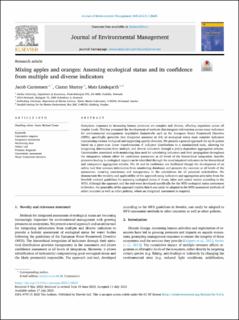Mixing apples and oranges: Assessing ecological status and its confidence from multiple and diverse indicators
Peer reviewed, Journal article
Published version
Permanent lenke
https://hdl.handle.net/11250/3083275Utgivelsesdato
2023Metadata
Vis full innførselSamlinger
- Publikasjoner fra Cristin - NIVA [2160]
- Scientific publications [1172]
Originalversjon
Journal of Environmental Management. 2023, 344, 118625. 10.1016/j.jenvman.2023.118625Sammendrag
Ecosystem responses to increasing human pressures are complex and diverse, affecting organisms across all trophic levels. This has prompted the development of methods that integrate information across many indicators for environmental management. Legislative frameworks such as the European Water Framework Directive (WFD), specifically prescribe that integrated assessme nt (IA) of ecological status must consider indicators representing various biological and supporting quality elements. We present a general approach for an IA system based on a piece-wise linear transformation of indicator distributions to a standardized scale, allowing for integrating information from multiple and diverse indicators through a policy-dependent aggregation scheme. Uncertainties associated with monitoring data used for calculating indicators and their propagation throughout the integration scheme allow for confidence assessment at all levels of the hierarchical integration. Specific pressures leading to ecological impact can be identified through the most impaired indicators in the hierarchical and transparent aggregation scheme. The IA and its confidence are facilitated though the development of an online tool that accesses information from monitoring databases and presents the outcome at all levels of the assessment, ensuring consistency and transparency in the calculations for all potential stakeholders. We demonstrate the versality and applicability of the approach using indicators and aggregation principles from the Swedish national guidelines for assessing ecological status of rivers, lakes and coastal waters according to the WFD. Although the approach and the tool were developed specifically for the WFD ecological status assessment in Sweden, the generality of the approach implies that it can easily be adapted to the WFD assessment methods of other countries as well as other policies, where an integrated assessment is required.

